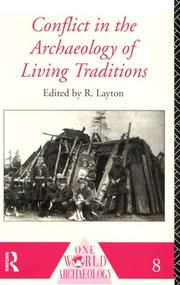| Listing 1 - 10 of 34747 | << page >> |
Sort by
|
Book
ISBN: 9789088901065 9088901066 Year: 2012 Publisher: Leiden Sidestone Press
Abstract | Keywords | Export | Availability | Bookmark
 Loading...
Loading...Choose an application
- Reference Manager
- EndNote
- RefWorks (Direct export to RefWorks)
What are European archaeologists doing abroad? What have they been doing there for the past three to four centuries? Are they doing things differently nowadays? To address these questions, this book explores the scope, impact and ethics of European archaeological policies and practices in the Mediterranean area, the Near East, sub-Saharan Africa, Asia and Latin America. Acknowledging that international and transcultural projects have a range of different stakeholders, the first part of this book aims to identify some of the values and motivations behind different European archaeologies abroad. This is done by providing thorough historical overviews on a range of European countries, including France, Spain, Germany, Belgium, the Netherlands and Poland. But how are these values translated, through socio-political, theoretical and administrative frameworks, unto local circumstances in host countries? And how are these archaeological activities received locally?
Periodical
ISSN: 11204559 Publisher: Milano : De Agostini periodici,
Abstract | Keywords | Export | Availability | Bookmark
 Loading...
Loading...Choose an application
- Reference Manager
- EndNote
- RefWorks (Direct export to RefWorks)
Book
ISBN: 0860545563 Year: 1988 Publisher: Oxford BAR
Abstract | Keywords | Export | Availability | Bookmark
 Loading...
Loading...Choose an application
- Reference Manager
- EndNote
- RefWorks (Direct export to RefWorks)
Periodical
ISSN: 14740540 09597743 Year: 1991 Publisher: Cambridge Cambridge University Press
Abstract | Keywords | Export | Availability | Bookmark
 Loading...
Loading...Choose an application
- Reference Manager
- EndNote
- RefWorks (Direct export to RefWorks)

ISBN: 041509559X 9780415095594 9780203988961 9781134866175 9781134866212 9781134866229 9781138161313 Year: 1994 Publisher: London & New York Routledge
Abstract | Keywords | Export | Availability | Bookmark
 Loading...
Loading...Choose an application
- Reference Manager
- EndNote
- RefWorks (Direct export to RefWorks)
Book
ISBN: 9781937040574 9786185209001 6185209004 1937040577 Year: 2016 Publisher: Atlanta, Georgia : Lockwood Press,
Abstract | Keywords | Export | Availability | Bookmark
 Loading...
Loading...Choose an application
- Reference Manager
- EndNote
- RefWorks (Direct export to RefWorks)
Book
ISBN: 3700182554 3700180713 Year: 2017 Publisher: Vienna Austrian Academy of Sciences
Abstract | Keywords | Export | Availability | Bookmark
 Loading...
Loading...Choose an application
- Reference Manager
- EndNote
- RefWorks (Direct export to RefWorks)
The present volume is the first in a series of monographs dedicated to the results achieved by AcrossBorders, a European Research Council Project (Austrian Academy of Sciences and Ludwig Maximilian University Munich). With its so-called Egyptian temple town and adjacent pyramid cemeteries, Sai Island is one of the prime examples for settlement policy of New Kingdom Egypt (c. 1530–1070 BC) in Upper Nubia (northern Sudan) and is the focus of this project. New fieldwork and multi-layered research conducted by the AcrossBorders project has provided fresh insights on living conditions in New Kingdom Nubia in direct comparison with Egypt.This volume is dedicated to SAV1 North, the sector situated along the northern enclosure wall. It was excavated between 2008 and 2012 by the Sai Island Archaeological Mission and processed within the framework of AcrossBorders. The principal focus of the book is the physical remains of SAV1 North: the architecture and material culture, with emphasis on the pottery and small finds. Datable to the mid to late 18th Dynasty, the building phase labelled as Level 3 was the heyday of sector SAV1 North – a time well-attested by several architectural remains with associated finds and pottery, which are all presented in the volume. A summary of thoughts on possible hints about the lifestyle and activities at SAV1 North preserved in the material remains completes AcrossBorders I. All in all, the evidence from SAV1 North underlines the important role Sai plays in understanding settlement patterns in New Kingdom Nubia.
Book
ISBN: 1108010288 0511731469 Year: 1915 Publisher: Place of publication not identified : Cambridge : publisher not identified, Cambridge University Press
Abstract | Keywords | Export | Availability | Bookmark
 Loading...
Loading...Choose an application
- Reference Manager
- EndNote
- RefWorks (Direct export to RefWorks)
J. P. Droop (1882-1963) was a classical field archaeologist. After graduating from Trinity College, Cambridge, in 1904 he worked as a field archaeologist for the British School at Athens, and was appointed Chair of Classical Archaeology at Liverpool University in 1914. This volume was intended as a guide to practical archaeological excavation and was first published in 1915 as part of the Cambridge Archaeological and Ethnological series. At the time of publication, archaeology was starting to become a more scientific and academic discipline, as can be seen in Droop's arguments on the importance of archaeological context and knowledge of stratification on site. The development of excavation as a scientifically based practice is shown by the emphasis on planning of the site, in contrast to earlier guides to excavation. This volume provides insights into the development of the theory as well as the practice of archaeology.
Periodical
Abstract | Keywords | Export | Availability | Bookmark
 Loading...
Loading...Choose an application
- Reference Manager
- EndNote
- RefWorks (Direct export to RefWorks)
Periodical
ISSN: 13574442 Publisher: York : Council for British archaeology,
Abstract | Keywords | Export | Availability | Bookmark
 Loading...
Loading...Choose an application
- Reference Manager
- EndNote
- RefWorks (Direct export to RefWorks)
| Listing 1 - 10 of 34747 | << page >> |
Sort by
|

 Search
Search Feedback
Feedback About
About Help
Help News
News